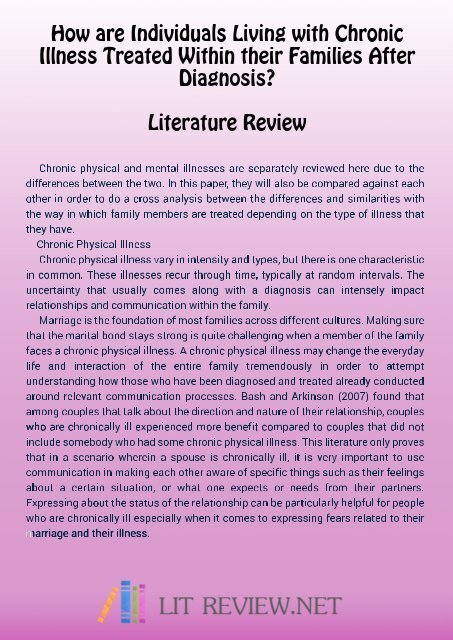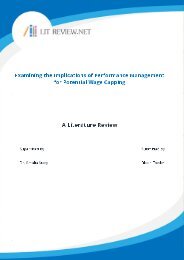APA Literature Review Sample
Hello! Look at this amazing APA literature review sample. To get more samples go to https://www.litreview.net/apa-format-literature-reviewstep-by-step/
Hello! Look at this amazing APA literature review sample. To get more samples go to https://www.litreview.net/apa-format-literature-reviewstep-by-step/
Create successful ePaper yourself
Turn your PDF publications into a flip-book with our unique Google optimized e-Paper software.
HowareIndividualsLivingwithChronic<br />
IlnessTreatedWithintheirFamiliesAfter<br />
Diagnosis?<br />
<strong>Literature</strong><strong>Review</strong><br />
Chronicphysicalandmentalilnessesareseparatelyreviewedhereduetothe<br />
diferencesbetweenthetwo.Inthispaper,theywilalsobecomparedagainsteach<br />
otherinordertodoacrossanalysisbetweenthediferencesandsimilaritieswith<br />
thewayinwhichfamilymembersaretreateddependingonthetypeofilnessthat<br />
theyhave.<br />
ChronicPhysicalIlness<br />
Chronicphysicalilnessvaryinintensityandtypes,butthereisonecharacteristic<br />
incommon.Theseilnessesrecurthroughtime,typicalyatrandom intervals.The<br />
uncertaintythatusualycomes along with a diagnosis can intenselyimpact<br />
relationshipsandcommunicationwithinthefamily.<br />
Mariageisthefoundationofmostfamiliesacrossdiferentcultures.Makingsure<br />
thatthemaritalbondstaysstrongisquitechalengingwhenamemberofthefamily<br />
facesachronicphysicalilness.Achronicphysicalilnessmaychangetheeveryday<br />
life and interaction ofthe entire family tremendously in orderto atempt<br />
understandinghow thosewhohavebeendiagnosedandtreatedalreadyconducted<br />
aroundrelevantcommunicationprocesses.BashandArkinson(2007)foundthat<br />
amongcouplesthattalkaboutthedirectionandnatureoftheirrelationship,couples<br />
whoarechronicalyilexperiencedmorebenefitcomparedtocouplesthatdidnot<br />
includesomebodywhohadsomechronicphysicalilness.Thisliteratureonlyproves<br />
thatinascenariowhereinaspouseischronicalyil,itisveryimportanttouse<br />
communicationinmakingeachotherawareofspecificthingssuchastheirfeelings<br />
aboutacertain situation,orwhatoneexpectsorneedsfrom theirpartners.<br />
Expressingaboutthestatusoftherelationshipcanbeparticularlyhelpfulforpeople<br />
whoarechronicalyilespecialywhenitcomestoexpressingfearsrelatedtotheir<br />
mariageandtheirilness.
BeanandUmali(2009)suggestedthataso-caledcolaborativetalkisthekindof<br />
communicationwhichiscorelatedcommonlywithpositiveresults.Thisonlygoes<br />
toshow thatitisveryimportantforalmariedcouplestotalkabouttheirissuesand<br />
situationaltogetherinordertokeeptheirrelationshipverystrongbecausethese<br />
tacticshavealreadybeenproventobevaluableforthecouple.Shim andSimon<br />
(2015)add to thisfurtherbyexplaining thatcoupleswho areawareofthe<br />
expectationsoftheirpartnersregardingcommunicationwithinthemariageare<br />
moresuccessfulinprovidingsupporttooneanother.Also,beingawareofthe<br />
desiresoftheirpartnersandbeingabletofulfilthem isimportanttowardsachieving<br />
satisfactioninthefunctioningoftherelationship.Maritalsharingandcopingisnot<br />
justlimitedtothetalkwithintherelationship.Anotherverypowerfulwayofdoingso<br />
isthroughnaratives.<br />
Narativesissomethingthatisrecognizedstronglyandoftenpraisedthrough<br />
literaturesonchronicphysicalilnesses.Variousstudies(Free&Chapman,2008;<br />
Otenson&Scot,2005;Dickson&Walker,2006)stresstheprimaryimportanceof<br />
communicatingwithnarativesforthehealingprocessofthefamily.Narativesare<br />
verybeneficialsincetheyalow studiesandresearchtocapturesomepersonal<br />
accountsofdisease,leting theilperson actasa gatekeeperoftheirown<br />
informationregardingtheirilness.OtensonandScoot(2005)statethatthosewho<br />
aredealingwithchronicphysicalilnessesaremorelikelytoshareactivelyiftheir<br />
perceptionsandfeelingsareconfirmedbyothers,especialyfamilyandfriends.<br />
Some chronic ilnesses result to a negative socialstigma,and receiving<br />
confirmationthatpeoplewilturnouttoberespectfulisveryimportantingetingthe<br />
patienttoshareandopenupregardingtheirexperiences.Storytelingandnaratives<br />
helpfamiliestoefectivelycommunicateregardingthechangesthattheyhave<br />
experienced and have taken place in the family.Otenson and Scoot(2005)<br />
concludedthatthechangingidentitywhilefacingtheilnessneverstops.Infact,it<br />
isendlesswheelofdevelopment.Sharingvianarativesincasesofdiferentchronic<br />
physicalilnesshasthepossibilityofexperiencingbetercommunicationinthe<br />
familybecausethepatientcanconciselyandclearlyexplainwhatiscurentlygoing<br />
onwiththem from theirpersonalperspective.
Thiscansignificantlyhelpthefamilydeterminewhatthepatienthasbeen<br />
through,whileunderstandingnew identitiesthatareemerging.However,Losch<br />
(1982)pointsouta veryimportantparadoxexplaining thatpatientsmaybe<br />
empoweredbyexplaininganarativeaccountoftheirstory,andothersmayalsofeel<br />
anxiousfrom rememberingthosemomentswithintheirlife.AsexplainedbyGrethel<br />
andSatchkinson(1992),whentheparticipantsusedcommunicationinreducingthe<br />
fearthattheyfeelregardingtheirilness,theyweremostlikelytocommunicate<br />
regardingtheirilnessbeter.WinsyandDenton(2006)show thatnarativesarevery<br />
importantinmeetingtheexpectationsandunderstandingofthefamilymembers<br />
whentheyexperiencechronicilness.Mostoften,peoplewilalsofaceexpectations<br />
fortheirfamilymemberswithoutevenexpressingthem verbaly,leavingthem<br />
confusedmoreoftenregardingthedirectionthattheyneedtotake.However,aform<br />
ofstorytelingornarativeincasesofchronicphysicalilnessmayalsoreflectsome<br />
oftheunfulfiledneedsofthepatients,helpingfamilymemberstodeterminethem.<br />
Ontheotherhand,achronicmentalilnesscanbequitedificultforfamiliesto<br />
dealwith,givenitsnegativesocialconnotationsinmostsocietiesalovertheworld<br />
today.Afamilymembersuferingfrom chronicmentalilnessmayleadtoconstant<br />
monitoringandcare,dependingontheintensityandtheilness.Assuch,families<br />
mayendupfindingitdificulttodealwithunderstandingthediagnosisofchronic<br />
mentalilnessduetothenumberofchalengespresented.(Smith,2009).<br />
References<br />
Bash,J.,&Arkinson,W.R.(2007).Dyadicadjustmentrequiredinchronicilness.Doesitmatertoengageinrelationshiptalks?FamilyPsychology<br />
Journal,21(5),467-471.doi:12.3534656-123.12.3.4543<br />
Bean,G.A.,&Umali,R.(2009).Adevelopmentalmodelofmariedcouplesdealingwithchronicilness.TheBuletinofPsychology,135(8),<br />
922-956.<br />
Dickson,W.E.,&Walker,G.A.(2006).Copingtechniquesamongcancerpatients:Imaginedinteractionsandactualcommunications.Health<br />
Communication.4,257-268.<br />
Free,G.A.,&Chapman,E.G.(2008).Culturalybasedapproachesinfamiliesanditspractices.ContemporarySocialServicesJournal.45(5),<br />
200-210.<br />
Grethel,D.F.,&Satchkinson,G.(1992).Docommunicationstylesmoderateinteractionbetweenmembersofthefamilies?FamilyCommunication<br />
Journal,12,153-144.doi:10.1080/2352352.123.2141<br />
Losch,A.D.(1982).Communicationresearchquestions:findinganswers.New York:ABCPress.<br />
Shim,A.,& Simon,W.(2015).Caring forcaregivers ofindividuals with mentalilness.JournalofPsychiatry.58(5),223-229.doi:<br />
10.355/124-135.5436<br />
Otenson,Q.,&Scot,A.(2005_.Healingandnaratives.Exploringthepossibilities.HealthCommunication.17(4),135-145.<br />
Winsy,A.,&Denton,Y.(2006).Thecancerjournals.Florida:Sheba.<br />
Smith,T.(2009).Stigmaandsocialdisruption–networkdynamicsinmentalilnesses.SocialandPersonalPsychology.33(2),23-34.







